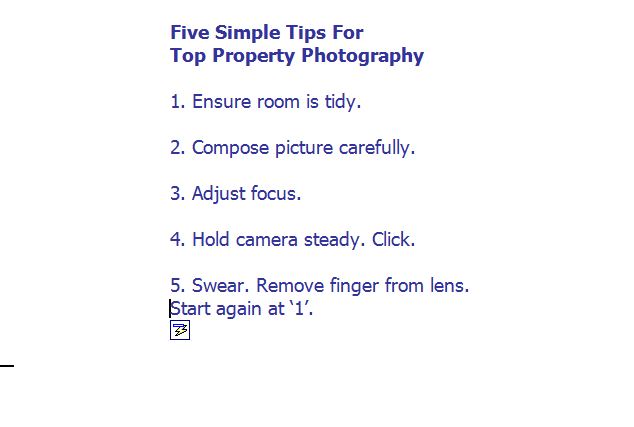Good property photography is more important now than ever. Now that so much house hunting is done online the photos are usually the very first thing that potential buyers (or tenants) look at, after the price. Good photos will encourage them to look further, and maybe even book a viewing – while bad photos could see them skip by your listing never to return.
And you don’t need just one good photo …. you need lots of good property photos. More photos mean prospective buyers will stay on your listing for longer. As with every type of online shopping the longer a visitor stays on your listing the more likely they are to think about your property, remember it …. and so the more likely they are to book a viewing.
Here are some tips on taking better property photography, even if you’re not a professional property photographer:
* You can’t take good property photos with a phone camera. A digital SLR camera is the ideal, but even a cheap digital camera with a digital zoom lens is capable of taking good quality pics by using a few clever tricks …. read on!
* Take lots of photos, and then select the very best ones to use. Even pro photographers use this technique.
As a rough guide, even as an amateur, you’ll find that every 5 or 6 photos taken contains at least one very good pic. So if you need 10-12 photos for your listing you should be thinking of taking at least 50 images to choose from.
* Perfect focus is essential. Don’t use badly-focussed photos. If you’re not sure how to focus a picture properly simply use the autofocus setting!
* Better light means better photos. Take your pics on a bright day if at all possible and avoid dull, overcast days.
Do what you can to control the lighting level inside the house so that it is bright, but not overpowering. Turn some lights on. On the other hand, on a very bright day, close some of the blinds or curtains to avoid glare.
Avoid using flash …. by and large only professionals can get good inside photos using a flash.
Night time shots (especially at dusk) can provide some stunning images for your listing – but they’re probably only worth doing for a special property.
* This is the very easiest way ever of getting better property photos: Use a tripod and a remote shutter release. You’ll eliminate the chance of camera shake and get sharper, better photos instantly!
* Photograph every room, but take more shots in the kitchen, bathrooms and main living area. These areas need at least 5-6 shots each, which all being well will result in at least two great ones to use.
* Sod’s Law of Property Photography dictates that the not-so-good points will always be emphasised in a photo. A property that looks messy in real life will look even messier in your photos! Make sure everything is tidy and well presented before your photo shoot.
* Photograph a lifestyle, not just a room. Get inspired – have a browse through some interior design magazines, websites and blogs. Notice the wine bottle and glasses carefully positioned on the kitchen counter, the neatly laid dinner table, the single cuddly toy on a child’s bed. So OK, this is real life and recreating these desirable settings won’t be possible …. but lifestyle is what your photos should be trying to convey.
* Compose every shot carefully. Think ‘straight and level’ when taking a pic. The vertical lines in the shot, such as wall and door edges, should be as near parallel to the edges of the photograph as possible. (This is the easiest way to avoid that skewed, ‘house that Jack built’ look in the end photo.)
Have a focal point, even if just the kitchen sink or a pot plant, in every picture. This makes your pic automatically more interesting. (It often works best if your focal point is just off the centre of the picture.)
* Provide a ‘view beyond’ in as many pics as possible. This adds interest to the photo, and a feeling of space. For example, a shot of the living room becomes much more interesting if there is a look beyond through an open door and out into the garden.
Taking the same shot that a viewer will see as they enter the room, ie. a shot from the doorway, seems the most obvious choice but is not always the best idea. A picture looking towards door and out into a ‘view beyond’ is usually more interesting.
* Taking a shot from corner to corner, rather than wall to wall, is more interesting and can make the room seem larger.
* Experiment with height, and see what works best for the property concerned. The best shot might not always be from eye-level height. Taking a pic from low down can make a room with a low ceiling seem more spacious, but taking a pic from low down in a room with a high ceiling can make it seem too lofty.
* External pics are just as, if not more, important than internal pics. Your first ‘masthead’ pic should almost always be an external shot. So take at least 5-6 of these to give you at least one good photo to use.
When taking your all important ‘kerbside shot’ adjusting your physical distance from the property so that it just fills the photo is a much easier approach for amateur photographers than using zoom. (A cheat that can work well for all property photography.)
Pics of the garden usually look best from the garden to the house rather than vice versa.
* Editing. Consider whether using Instagram-style filters to add colour or effects is a good idea or not. It often isn’t, and will make your photos look fake.
It’s perfectly acceptable to edit your property photographs to, for example, remove blemishes or adjust the colour. You can even ‘airbrush’ your pics to enhance them using basic photo editing software. But know what reasonable boundaries are. Airbrushing out dirty laundry might be acceptable, but airbrushing out the electricity substation next door probably isn’t.


